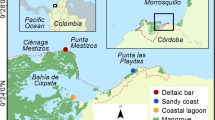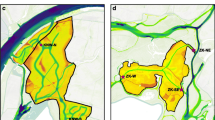Abstract
The physical processes such as coastal currents, estuarine circulation and monsoon winds prevailing in the Rufiji delta are discussed. The relationship between these processes and the occurrence of long-term trapping of the river discharge and the outflow of waters from the mangrove swamps into the nearshore zone has been observed. The trapped waters in the nearshore zone significantly reduce the mixing between the estuarine and offshore waters, leading to the two waters having distinctive properties. The existence of the trapped waters in the nearshore zone is supported by evidence from a satellite image and aerial photograph and measurements of salinity and suspended sediment concentration. The trapping phenomenon is discussed in the light of its possible implications on the ecology of mangrove ecosystems. Trapping may explain the enhanced growth of the mangrove in the delta compared to other areas. This trapping effect may be providing more time for nutrient retention in the mangrove zone, incorporation of the decomposed leaf litter and fine sediments in the substrate, and settling of fruits and seedlings in the swamps, thereby enhancing the regeneration of the mangrove.
Similar content being viewed by others
References
Bryceson, I., 1977. An ecological study of the phytoplankton of the coastal waters of Dar-es-Salaam. Ph.D. Thesis, University of Dar-es-Salaam.
Cintron, G. & Y. Schaeffer-Novelli, 1983. Mangrove Forests: Ecology and response to natural and man-induced stressors. In J. C. Ogden & E. H. Gladfelter (eds), Coral reefs, seagrass beds, mangrove; Their interaction in the coastal zones of the Caribbean. UNESCO report in marine science 23: 87–113.
Euroconsult., 1980. Identification study on the ecological impacts of the Stiegler's Gorge Power and Flood Control Project Part 2: Methodology, Definition of impact area and Resources inventory.
Iversen, S. A., S. Myklevoll, K. Lwiza & Y. Yonazi., 1984. Tanzanian marine fish resources in the depth region 10–500 m investigated by R/V ‘Dr. Fridtjof Nansen’. In S. A. Iversen & S. Myklevoll (eds), The Proc. of the NORAD-Tanzania Seminar to review the marine fish stocks and fisheries in Tanzania. Mbegani, Tanzania. March 6–8, 1984: 45–83.
MacNae, W., 1968. A general account of the fauna and flora of mangrove swamps and forest in the Indo-West Pacific region. Adv. Mar. Biol. 6: 73–270.
Newell, D. S., 1959. The hydrography of the British East African Coastal Waters. Fishery Publs. Colon. Off. No. 12. 18 pp.
VHL., 1979. Hydrological studies in the Lower Rufiji River. Trondheim, Norway. 100 pp.
Wolanski, E., 1989. Measurements and modelling of the water circulation in the mangroves swamps. Results of practical work at the COMARAF Regional Field Training Workshop on Mangrove Ecosystems and Estuarine Processes. Chwaka Bay, Zanzibar. June 6–16, 1989. Regional Project RAF/87/038.
Wolanski, E. & P. Ridd, 1986. Tidal mixing and trapping in mangrove swamps. Estuar. coast. mar. Sci. 23: 759–771.
Wolanski, E. & P. Ridd, 1989. Coastal mixing and trapping in tropical Australia. In R. T. Cheng (ed.), Dynamics of Shallow Bays and Estuaries. (in press).
Woodroffe, C. D., 1985. Studies of a mangrove basin, Tuff Crater, New Zealand: 1. Mangrove biomass and production of detritus. Estuar. coast. mar. Sci. 20: 265–280.
Author information
Authors and Affiliations
Rights and permissions
About this article
Cite this article
Francis, J. Physical processes in the Rufiji delta and their possible implications on the mangrove ecosystem. Hydrobiologia 247, 173–179 (1992). https://doi.org/10.1007/BF00008216
Issue Date:
DOI: https://doi.org/10.1007/BF00008216




